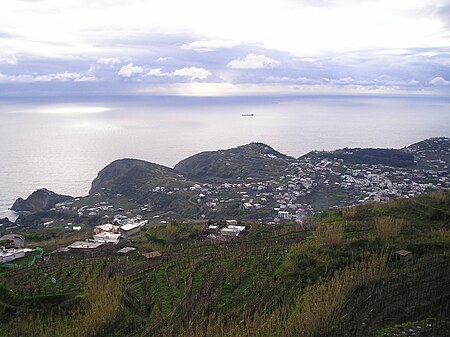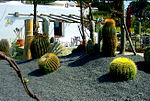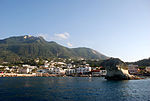Ischia ( ISK-ee-ə, Italian: [ˈiskja], Neapolitan: [ˈiʃkjə]) is a volcanic island in the Tyrrhenian Sea. It lies at the northern end of the Gulf of Naples, about 30 km (19 mi) from Naples. It is the largest of the Phlegrean Islands. Roughly trapezoidal in shape, it measures approximately 10 km (6 mi) east to west and 7 km (4 mi) north to south and has about 34 km (21 mi) of coastline and a surface area of 46.3 km2 (17.9 sq mi). It is almost entirely mountainous; the highest peak is Mount Epomeo, at 788 m (2,585 ft). The island is very densely populated, with 62,000 residents (more than 1,300 inhabitants per square km).Ischia is also well known for its thermal water and thermal gardens used since ancient times. Its volcanic nature makes Ischia one of the largest spas in Europe. Ischia's thermal waters are alkaline. Already the first Euboic settlers (8th century BC), as evidenced by the numerous archaeological finds found in the site of Pithecusa and preserved in the Archaeological Museum of Villa Arbusto in Lacco Ameno, appreciated and used the waters of the island's thermal springs. The Greeks, in fact, used the thermal waters to restore the spirit and the body and as a remedy for the healing of the after-effects of war wounds (in the pre-antibiotic era), attributing supernatural powers to the waters and vapors that gushed from the earth; it is no coincidence that temples dedicated to divinities such as that of Apollo in Delphi rose in every spa town. Strabo, a Greek historian and geographer, mentions the island of Ischia and the virtues of its thermal springs in his monumental geographical work (Geograph. Lib. V). If the Greeks were the first peoples to learn about the powers of thermal waters, the Romans exalted them as an instrument of care and relaxation through the creation of public Thermae and they used the numerous springs of the island surely and profitably (as evidenced by the votive tablets found at the Source of Nitrodi in Barano d'Ischia, where there was a small temple dedicated to Apollo and to the Nitrodie Nymphs, guardians of the waters) even without lavish settlements; In fact, on the island, as in Rome and in other ancient thermal centres, no impressive vestiges of thermal buildings have been found, probably due to volcanic eruptions and earthquakes that frequently violently shook the crags. The decline of the power of Rome coincided with the abandonment of the use of bathrooms also in Ischia: in fact, there are no traces of the use of water in the Middle Ages.
Ischia is the name of the main comune of the island. The other comuni of the island are Barano d'Ischia, Casamicciola Terme, Forio, Lacco Ameno and Serrara Fontana.











